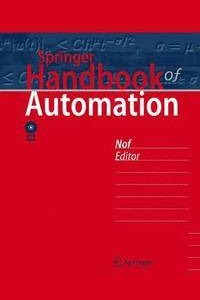
Liknande böcker
Springer Handbook of Automation
Bok av Shimon Y. Nof
Automation is undergoing a major transformation in scope and dimension and plays an increasingly important role in the global economy and in our daily lives. Engineers combine automated devices with mathematical and organizational tools to create complex systems for a rapidly expanding range of applications and human activities. The Springer Handbook of Automation incorporates these new developments and presents a widespread and well-structured conglomeration of new emerging application areas of automation. Besides manufacturing as a primary application of automation, the handbook contains new application areas such as medical systems and health, transportation, security and maintenance, service, construction and retail as well as production or logistics. This Springer Handbook is not only an ideal resource for automation experts but also for people new to this expanding field such as engineers, computer scientists, designers. It is edited by an internationally renowned and experienced expert.Chapters in Part A explain the significant influence of automation on our life, on individuals, organizations, and society, in economic terms and context, and impacts of precision, accuracy and reliability with automatic and automated equipment and operations. The theoretical and scientific knowledge about the human role in automation is covered in Part B from the human-oriented and human-centered aspects of automation to be applied and operated by humans, to the human role as supervisor and intelligent controller of automation systems and platforms. This part concludes with analysis and discussion on the limits of automation to the best of our current understanding. Covering automation design from theory to building automation machines, systems, and systems-of-systems , Part C explains the fundamental elements of mechatronics, sensors, robots, and other components useful for automation, and how they are combined with control and automation software, including models and techniques for automation software engineering, and the automation of the design process itself. Chapters in Part D cover the basic design requirements for the automation and illustrate examples of how the challenging issues can be solved for the deign and integration of automation with respect to its main purpose: Continuous and discrete processes and industries, design techniques, criteria and algorithms for flow lines, and integrated automation. Concluding this part is the design for safety of automation, and of automation for safety. The main aspects of automation management are covered by the chapters in Part E: Cost effectiveness and economic reasons for the design, feasibility analysis, implementation, rationalization, use, and maintenance of particular automation; performance and functionality measures and criteria. Related also are the issues of how to manage automatically and control maintenance, replacement, and upgrading. Part F, industrial automation, begins with explanation of machine tool automation, including various types of numerical control (NC), flexible, and precision machinery for production, manufacturing, and assembly, digital and virtual industrial production, to detailed design, guidelines and application of automation in the principal industries, from aerospace and automotive to semi-conductor, mining, food, paper and wood industries. Chapters are also devoted to the design, control and operation of functions common to all industrial automation. Infrastructures and service automation are covered in Part G and it is explained how automation is designed, selected, integrated, justified and applied, its challenges and emerging trends in those areas and in the construction of structures, roads and bridges; of smart buildings, smart roads and intelligent...







